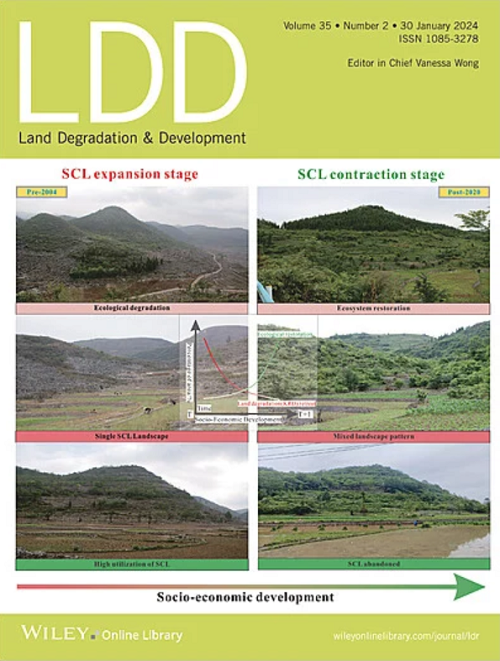Poplar–Soybean Intercropping and Fertilizer Application Increased Soil Fungal Diversity and Nutrient Content
IF 3.6
2区 农林科学
Q2 ENVIRONMENTAL SCIENCES
引用次数: 0
Abstract
Intercropping significantly affects soil microbial communities and nutrient content; however, the influence of intercropping with fertilizer application on them has yet to be elucidated. A pot experiment was performed with three planting patterns: P (poplar monoculture; Populus deltoides), S (soybean monoculture; Glycine max) and PS (poplar–soybean intercropping), with three fertilizer application rates of 0, 5, and 10 g (10 kg of soil per pot). The soil properties and fungal community under different treatments were analyzed. Planting patterns and fertilizer application rates significantly influenced soil properties and fungal communities. The PS pattern exhibited significantly higher soil organic matter (SOM), total nitrogen (TN), total phosphorus (TP), total potassium (TK), and ammonium nitrogen (NH4+-N) contents; greater urease (UR) and sucrase (SUR) activities; and greater soil fungal diversity than did the S and P patterns. Soil nitrate nitrogen (NO3−-N), available phosphorus (NH4+-N, AP), available potassium (AK) contents, UR, SUR activities; and fungal diversity increased with a higher fertilizer application rate, with the highest values occurring in the 10 g fertilizer treatment. Structural equation modeling revealed that intercropping and fertilizer application affected soil nutrients by altering fungal community and enzyme activity. Soil water content and NO3−-N content were the dominant factors affecting the soil fungal community (p < 0.05). The PS pattern significantly decreases the relative abundance of soil pathogenic fungi and increases the relative abundance of soil fungi related to SOM transformation and nutrient utilization efficiency. In conclusion, these findings emphasize the importance of poplar intercropping and fertilizer application on soil quality, providing guidance for the selection and management of planting patterns in agriculture to improve soil quality.杨树-大豆间作和施肥增加了土壤真菌多样性和养分含量
间作对土壤微生物群落和养分含量影响显著;然而,间作施肥对它们的影响尚不清楚。盆栽试验采用3种种植模式:白杨单作;杨树(deltoides), S(大豆单一栽培;甘氨酸(Glycine max)和PS(杨豆间作),施用3种肥料,分别为0、5和10克(每罐10公斤土壤)。分析了不同处理下的土壤性质和真菌群落。种植方式和施肥量对土壤性质和真菌群落有显著影响。PS模式显著提高了土壤有机质(SOM)、全氮(TN)、全磷(TP)、全钾(TK)和铵态氮(NH4+-N)含量;脲酶(UR)和蔗糖酶(SUR)活性较高;土壤真菌多样性高于S和P模式。土壤硝态氮(NO3−-N)、速效磷(NH4+-N、AP)、速效钾(AK)含量、UR、SUR活性;真菌多样性随施肥量的增加而增加,以10 g施肥量最高。结构方程模型表明,间作和施肥通过改变真菌群落和酶活性来影响土壤养分。土壤含水量和NO3−-N含量是影响土壤真菌群落的主要因素(p < 0.05)。PS模式显著降低了土壤病原真菌的相对丰度,提高了与SOM转化和养分利用效率相关的土壤真菌的相对丰度。综上所述,这些研究结果强调了杨树间作和施肥对土壤质量的重要性,为农业种植模式的选择和管理提供了指导,以改善土壤质量。
本文章由计算机程序翻译,如有差异,请以英文原文为准。
求助全文
约1分钟内获得全文
求助全文
来源期刊

Land Degradation & Development
农林科学-环境科学
CiteScore
7.70
自引率
8.50%
发文量
379
审稿时长
5.5 months
期刊介绍:
Land Degradation & Development is an international journal which seeks to promote rational study of the recognition, monitoring, control and rehabilitation of degradation in terrestrial environments. The journal focuses on:
- what land degradation is;
- what causes land degradation;
- the impacts of land degradation
- the scale of land degradation;
- the history, current status or future trends of land degradation;
- avoidance, mitigation and control of land degradation;
- remedial actions to rehabilitate or restore degraded land;
- sustainable land management.
 求助内容:
求助内容: 应助结果提醒方式:
应助结果提醒方式:


